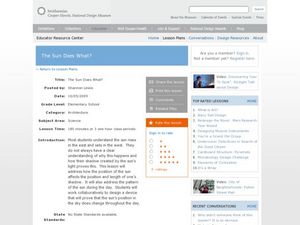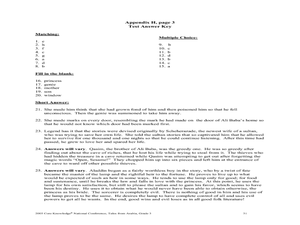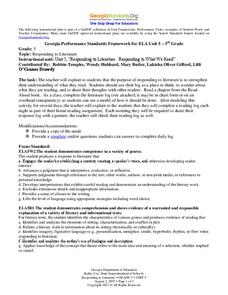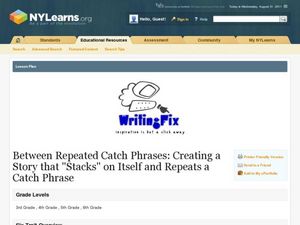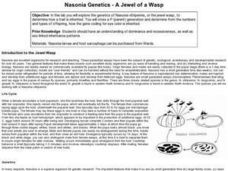Curated OER
A Poem for My Mother
In this holiday instructional activity, students print out a Mother's Day poem and draw an original illustration below it. They sign the card on the elementary line below the illustration.
Curated OER
Hello Sun, Goodnight Moon
Students become familiar with different times around the world through the reading of 9 O'clock Lullaby. In this Earth, sun, moon lesson, students recognize the movement of the Earth and the relationship to the sun and the...
Curated OER
The Sky Jeopardy
First graders reinforce concepts about sun, moon, day, night and sky by playing the Sky Jeopardy game. In the end, 1st graders get to nibble crackers in order to show the different phases of the moon.
Curated OER
The Winter Solstice
In this winter solstice worksheet, students read a detailed text about the winter solstice and the historical and religious significance of this day. Students then complete a 15 question fill-in-the-blank and true/false worksheet.
Curated OER
Dinosaur Stomp
Second graders write a dinosaur poem using information from a research activity. In this dinosaur poetry and music lesson, 2nd graders listen to the book Saturday Night at the Dinosaur Stomp in music class. They work in small groups to...
Marcia's Science Teaching Ideas
Observing the Moon Activity
In this moon worksheet, students observe the moon on three consecutive nights and draw their observations. They answer questions about the phases of the moon and its position in the night sky. They identify the position of the sun, earth...
Curated OER
Nocturnal vs. Diurnal Animals
First graders identify nocturnal and diurnal animals. In this animal lesson, 1st graders discuss the differences between animals that are active during the day and those that are active at night. Students write summaries about their...
Curated OER
The Sun Does What?
Students examine why the sun rises in the east and sets in the west. In this sun lesson, students explore the sunset and shadows. Students prove that the sun's position changes during the day. Students investigate what causes a shadow....
Curated OER
What is a Balanced Menu?
Young scholars create a menu following food pyramid guidelines. In this nutrition lesson, students plan a menu by finding magazine pictures from each food pyramid group. Next, young scholars create a menu for an entire day.
Beacon Learning Center
Challenging the Human Spirit
High schoolers select a theme-related essay topic from Night, by Elie Wiesel, or The Metamorphosis, by Franz Kafka, and develop an essay that relates the theme to modern-day personal experiences. The essay follows a preset rubric...
Curated OER
Antonym Test
In this antonym learning exercise, students write the antonym for 8 words and write the antonym for the underlined word in 10 sentences. Antonyms include night-day, won-lost, hot-cold, etc.
Curated OER
Why We Need Sleep
Fifth graders track how much sleep they get and list reasons sleep is important. In this health and math lesson, 5th graders keep up with their sleep times for a week and make notes about how they feel each day prior to the lesson. The...
Curated OER
Tales from Arabia
Third graders explore and develop interest in reading of foreign lands through the reading of The Arabian Nights and a variety of Cinderella stories. Students participate in a variety of folk literature activities. Students recognize the...
Curated OER
Responding to Literature
Fifth graders examine how to respond to literature. In this literature response lesson, 5th graders discuss how to respond to literature. They write a response in a literature log each night based on their reading and the connections...
Curated OER
Measuring Transpiration
In this transpiration worksheet, students will conduct an experiment to measure the rate of transpiration from a plant by measuring how much weight the plant loses over 5 days. Students will record their data and create a graph of the...
Curated OER
First Grade Tour Guides
First graders plan a tour to give their parents on a school parent night. In this school tour lesson plan, 1st graders gather information about their school, determine how to best present information, and prepare a tour and talk to give...
Curated OER
I'm Warm Now
Third graders graph how much water is wasted while waiting for it to get warm in the spigot in the sink. In this graphing lesson plan, student first predict how much water is wasted. That night they test it out at home and the next day...
Curated OER
Creating a Story that "Stacks" on Itself and Repeats a Catch Phrase
Students explore language arts by reading a classic children's story in class. In this story structure activity, students read the Judith Viorst book, Alexander and the Terrible, Horrible, No Good, Very Bad Day. Students discuss the...
Curated OER
TOTAL LITERATURE SERIES
Fifth graders listen and react to the book Number the Stars, by Lois Lowry. They write in their journals every day approximately one page or more as a reflection on the reading.
Curated OER
Time Zone Math
For this algebra worksheet, students calculate the different time of the day that different countries see the sun. They convert between different time zones. There are 3 questions with an answer key.
Curated OER
World In Motion Curriculum
Young scholars explore the night sky and its solar system. Using a Digitarium planetarium system, students observe four constellations. They discover the phases of the moon and eclipses. Young scholars recognize the difference between...
Curated OER
Genealogy through Technology
Students research their family history. In this genealogy instructional activity, students research their own family. Students use storyboarding to organize their information. After gathering information students create a Powerpoint...
Curated OER
Who Did It?
Students explore how forensic science is used in criminal investigations. They learn that for the next few days that are going to try to solve a crime that took place in the classroom. Students are given a story to read about the crime...
Curated OER
Nasonia Genetics-A Jewel of a Wasp
Students investigate the inheritance pattern of eye color in Nasonia wasps. In this genetics and inheritance lesson plan, students read about the life cycle of Nasonia wasps and hypothesize about the possibilities of eye color inherited...
Other popular searches
- Day and Night
- Day/night
- Day and Night Sky
- Science Day and Night
- Day and Night Cycle
- What Makes Day and Night
- Day and Night Time
- Earth Day and Night
- Day and Night Rotation
- Modeling Day and Night
- Opposites Night and Day
- What Causes Day and Night









